So it came to pass that greed and short-sighted foolishness saved Godzilla from an early death after 1968’s Destroy All Monsters. The next year’s entry, Godzilla’s Revenge, was a half-thought-out desperation play, rushed into theaters before anyone could notice just how final the final shots of Destroy All Monsters really were…especially that long pull-back of Godzilla and Son as the two literally wave goodbye to the camera…
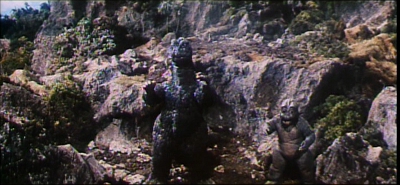
…as much as they could in those suits.
No one bought it, even back then. Hell, these early films trained us to expect Godzilla to finish up each movie by falling into the sea, the better to rise again, next time. A pleasant goodbye wave is tantamount to tacking “Godzilla will return in…” onto the end of the credits, like most of James Bond’s flicks (which were reaching new heights of popularity by this time).
Toho figured this out quickly, and while Godzilla’s Revenge was no powerhouse, no one (with the possible exception of its director and original crew) really expected it to be. It was a stop-gap measure, made by people who nevertheless took their jobs seriously and shot for the moon. They missed (so wildly their shot is still traveling through the void of interstellar space today, waiting to ruin someone’s good time off in the Kalium Galaxy) but that’s not important now. Godzilla’s Revenge bought Toho time to find and hire replacements.
This film, alternatively known by the title above and by its Secret Name, Godzilla vs. The Smog Monster – marks the point where Godzilla’s original film series officially passed into the hands of the B-team. Godzilla’s original director/co-creator Ishiro Honda made one last monster movie in 1970 – the not-very-fondly-remembered Yog – before moving on to TV. Godzilla’s original producer/co-creator, Tomoyuki Tanaka, looked up from the daily grind and found himself the old man in the room, pushing sixty and well on his way to becoming the Grand High Overseer (or “Senior Producer,” as he’s credited) of all Toho sci-fi productions. Akira Ifukube, who scored all of the best Godzilla films, moved on to New Wave samurai flicks, like Zatoichi’s Consipracy, and Old Wave ones, like The Last Samaurai. Eiji Tsuburaya, the man who flat-out invented most of Japan’s post-war special effects techniques, died in January, 1970, only a year younger than the twentieth century itself. Of those present at Godzilla’s birth, only the actor in his suit, Haruo Nakajima, returned for this eleventh outing. The long-term fan might take some solace from Takeshi Kimura’s presence in the writing credits (even under one of his professional pseudonyms), but the facts remain: it’s a Brand New Day in Godzilla’s universe, with a brand new Captain at the helm: Yoshimitsu Banno.

Banno began his career as an assistant director on several of your favorite Kurosawa films, including Throne of Blood (a.k.a. “the one based on The Scottish Play”) and Hidden Fortress (a.k.a. “the one Star Wars is based on”). He went on to assist in the directing of dramas, crime-dramas, and slice-of-life dramas, mostly lost to us now, due to the fact none starred giant monsters or mushroom aliens, and therefore remain undistributed outside Japan. None of them qualified Banno to take the reigns of the longest-lasting and most-beloved giant monster series in all of moviedom anyway.
No. He got this job because, exactly one year before, he made a by-all-accounts-impressive A/V presentation about the volcanic activity that birthed the Japanese islands called, appropriately enough, The Birth of the Japanese Islands. This played in the Mitsubishi booth of Osaka’s 1970 International Trade Expo (the setting of Gamera vs. Jiger), where someone (maybe even Tomoyuki Tanaka) must’ve seen and liked it. A lot.
Legend has it Tanaka, and his bosses higher up the Toho Studios food chain, were intent on grooming Banno for a long-term sit in the Godzilla series director’s chair…though, given how things turned out, these legends may be retroactive, self-serving wish-fulfillment on Banno’s part. Whatever the case, they gave Banno as free a reign as Japanese movie studios ever give first time directors. The reigns loosened even further after Tanaka entered the hospital, where he spent most of the production…and probably wished he could return to once he saw the results.

Not that Hedorah‘s a recycled piece of shit – like Godzilla’s Revenge – but it is, after that flick, the Second Weirdest Godzilla Movie To Date. It ignores basic movie-making conventions for no reason, while ignoring others for very definite reasons, creating the deep-seated insecurity that, at any given moment, the movie might be fucking with you. On the other hand, it’s much more of a real movie than it’s immediate predecessor, consisting of 100% New Footage, and all the trimmings you’d expect from the ten other movies in this series. Godzilla. Another monster. A Scientist. Property damage. They’re all here in abundance. It can almost make you look past what’s missing.
We could start with coherence. That would be nice. But maybe I’m being unfair. Maybe the whole production was rushed and they forgot to film crucial scenes, or write them out in the first place. Maybe Banno really wanted a ten-year-old protagonist, like Honda gave us, two years before…maybe the choice to give said ten-year-old all the good lines and make him the driving force behind every major plot point had nothing at all to do with the continued popularity of the rival Gamera series. Maybe it’s all just an amazing coincidence.
But I doubt it. When Hedorah first comes ashore, the scene switches to a nightclub full of posh young people in the best fashions early-’70s Japan had to offer. I can feel the old men behind the camera shaking their fingers at the Youth of Their Day. Look at ’em all – drinking and dancing and singing and drug-tripping and sexing their lives away while pollution monsters battle in their streets. It’d be an interesting commentary on contemporary youth culture…if it weren’t completely facile…and if the first Gamera movie hadn’t made the same point six years prior. At least Gamera crushed all the Dancing Fools that chose to party hearty rather than run screaming. The Hedonistic Youth of Godzilla vs. Hedorah escape their nightclub…though the scene’s buttoned by this shot of a cat someone dipped in Smog Monster goo, to let us know we’re supposed to feel sad and stuff.
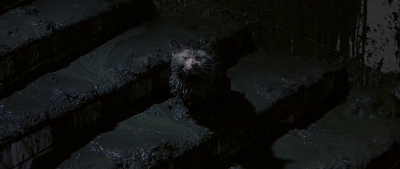
In fact, this movie has a complex relationship with the Youth of Its Day. They pop in again near the end, giving voice to an uncomfortably-recognizable breed of nihilism that had infected nearly all the idealistic philosophies of the ’60s by this point. The Days of Rage were long gone, the concessions won by them already rolling back, and the belief that collective action could change the world for the better was already on its way out, man. That’s, like, political and stuff. Who wants to be associated with all that? As the Least Callow among Smog Monster‘s cadre of Callow Youth says to the party he’s assembled at the base of Mt. Fuji:
“…why complain about it? There’s no place else to go and pretty soon we’ll be dead! So forget it! Enjoy yourselves! Let’s sing and dance while we can! C’mon! Blow your mind!”
It’s like the 1970s are speaking directly to me. Yet, these Anti-Hippies rush to Godzilla’s defense later on, taking up torches like a village mob right out of a Universal horror film and attacking the two-hundred found mound of toxic sludge that’s crashed their party. Yeah, they’re idiots…but at least they find something to believe in before they die. Their meaningless deaths can mean something…if only to us, the audience.
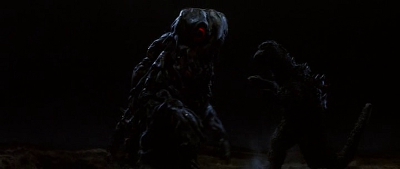
Contradictions are all over Godzilla vs. Hedorah. The plot is a simple “Godzilla fights a monster that may or may not be extra-terrestrial in origin” story, following well-established series outlines. Our Human Protagonist is a ten-year-old named (in the dub) Ken (Hiroyuki Kawase), with the bog-standard Super Scientist dad in Dr. Yano (Akira Yamauchi). As the film opens, a fisherman brings a big, fat, weird-looking “tadpole” to the Yano household, setting both the Yano males on a quest to discover the mysterious biological secrets of this alien organism.
Unfortunately, this involves an extended scuba-diving scene, as Dr. Yano goes fishing for more specimens. He finds one big enough to break oil tankers in half, and there’s a wonderful moment where Young Hedorah breaks the surface and leaps over Young Yano, in the style very similar to Free Willy‘s movie posters. Yano the Younger escapes unharmed, and left standing by the sea, plaintively calling after his “Papa!” in increasingly grating tones, until I wish Hedorah would come back and turn this latest Kenny into a Toxic Avenger. For a moment, I’m hoping Dr. Yano’s dead, supplying Kenny will some real motivation to spend the rest of the moving seeking out and destroying Hedorah.
But no. Cut to Dr. Yano, safe at home, with his family and the local media arrayed around him, broadcasting his story to all concerned. “Television can show people how serious this is,” Dr. Yano says, showing off the gray scar across half his face that he must’ve received off-screen. How’d he get away from the gelatinous blob? How did Kenny (ninety-eight pound weakling that he is) drag his dad up from the depths and get him back home? To quote Dr. Yano – whom I will now called Dr. Two-Face – “I think it’s something they ought to see.” “They” meaning “us,” again.
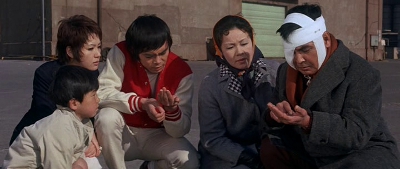
However, the omission of all those scenes allows us to get to the opening monster bout much faster than previous Godzilla films. I will give it that. The fights here have the potentially to be doozies, sadly never realized. Whoever designed Hedorah hit upon Godzilla’s perfect physical foil, accidentally or on purpose, it doesn’t matter. Can’t punch a blob, and blasting it with atomic breath only sends chunks flying, the better for them to slither away and reconstitute somewhere else, dragging the already-thin plot out to feature length. We get to that point…but only after an agonizing amount of the monsters posing, sizing each other up, and generally acting like the TV kaiju they were competing against. We’ll be seeing a lot more of that as Godzilla’s original series winds down.
Meanwhile, there’s a very simple formula to Godzilla vs. Hedorah:
Step One: The Expositional News Network informs us something is going on.
Step Two: Cut to Dr. Two-Face, doing Science, with Kenny #2214 attending. Slowly but surely, Dr. Two-Face unlocks the secrets of the Smog Monster, eventually discovering the obvious-in-retrospect solution: “kill it with fire!” Or, more accurately, “dry it out with electricity.”
Step Three: The monster action we all came to see.
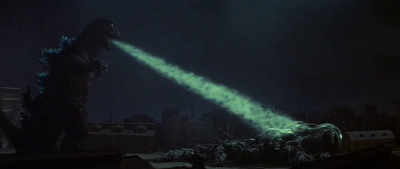
Step Four: An interruption to said action with some short animated sequence or montage. My favorite comes as Kenny reads a “poem” he wrote over scenes of massive garbage islands rolling along the ocean:
“The atomic bomb – the hydrogen bomb -cast their fallout into the sea. Human waste, poision gas, everything ugly is put into the sea and all life dies. Godzilla would really get angry if he saw this. He would do something. Class A, 2nd Grade, Ken Yano.”
Step Five: Repeat from Step One. It’s as if the movie were cut together in fifteen minute chunks, and its makers were so afraid someone might walk in late, they built in redundant systems to explain everything to everyone. This is a standard tactic adults use when they feel they’re making a film for The Children. Hence the ecological message mongering, increased emphasis on Monster Wrestlin’, interminable scenes where Dr. Two-Face speculates on Hedorah’s origins (“it probably came from a sticky, dark planet, far, far away.”) and the fact Godzilla flies under his own power for a minute, near the end, by tucking his tail between his legs and using his atomic breath as a make-shift jet. Which is another one of those things everyone talks about that’s actually the least interesting thing about the movie it’s in.

For example, because Japan has no knee-jerk, Puritanical qualms about putting gruesome images in their “children’s” films, there is more street-level carnage here than in any Godzilla movie since the first. Fitting when your antagonist is made of industrial waste and farts sulfuric acid, either smothering the populace in black mud or reducing them to charred skeletons for Kenny to stumble upon.
In one scene, a construction worker in the uncompleted floors of a high rise takes a header off the high steel as Hedorah flies past, skeltonizing him before he hits the ground. The Expositional News Network give us both damage estimates and body counts, selling the threat of Hedorah in the most direct and blatant manner possible…until globs of Smog Monster begin to burn Godzilla’s skin. Then the King of Monsters gets one right in the eye, making him as two-faced as our Intrepid Scientist. Godzilla gets his own back, of course, and both monsters finish up the fight with more scars than anyone not named “Gamera.” This is the film where Godzilla flies, yes. But it’s also the film where he literally rips out his enemy’s balls.

I feel a little more schizophrenic now, thanks to this schizophrenic film. By trying to pull Godzilla in contradictory directions, all it does is pull apart the minds of its audience. It’s New Wave stylistic tics showcase a mind behind the camera, but it’s typical plot and pedestrian direction can’t support any real aesthetic stretching. It’s like a music video director tried to do I, Robot as an action movie, in some desperate bid to capture The Youth,Market…oh…wait…that actually happened, didn’t it?
It’s a mixed bag and, as such, can become a chore to sit through, unless you’re surrounded by friends you’re trying to impress by being witty. Not quite the chore of, say, the Gamera films that were its competition…but still.
Legend has it Tanaka flat-out accused Banno of “ruining” Godzilla when he saw this, prefiguring the calls of fanboys everywhere whenever a director makes a film they don’t like. And whenever someone lobs that charge against a filmmaker, you can rest assured the accuser is seeking refuge in hyperbole, on the borderlands of Nonsense. You can’t “ruin” a fictional character, except by packing him in mothballs and letting his successful franchise lie fallow for… let’s say, “a decade at a stretch.”
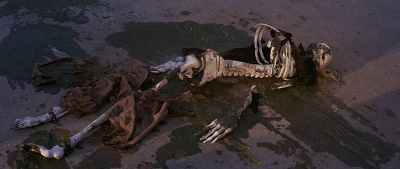
But unlike your average fanboy, Tanaka was in a position to put his company’s money where his ego wasn’t. He pulled the plug on Banno’s proposed sequel (where Godzilla would fight a second Hedorah in Africa) and handed the directorial reigns back to previous pinch-hitter Jun Fukuda. The results were…something we’ll discuss another time. But Banno’s involvement with Godzilla doesn’t end there.
After Tanaka died in 1997, freeing those he’d declared persona non grata to re-apply for jobs, Banno tried his best to rejoin the professional Godzilla family. By the time of the Big G turned fifty, Banno was already raising money for what he promised would be a forty-minute IMAX movie: Godzilla 3D: To the Max. That crappy title, Banno’s involvement, and my hatred of 3D (and the ticket-price inflation it’s designed to justify) all gave me reason to fear the project, and to this day I thank God(zilla) it never saw the light of day.
Instead, after another half-decade of absolutely nothing, Legendary Pictures announced a full-on Godzilla reboot of their own in 2010….Executive Produced by none other than one-time Godzilla vs. The Smog Monster director Yoshimitsu Banno. Funny old world we live in, isn’t it?
![]()
![]()
![]()
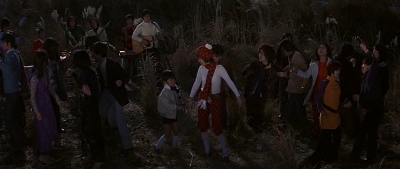

So I read this and I thought to myself ‘Holy Mackerel, the guy who did Godzilla vs the smog monster also did a volcanology documentary on the growth of an island arc? I’ve gotta see this!’ One half of an hour later I still haven’t seen any of it and netflix has decided that I must be desperately interested in watching ‘The Birth of a Nation.’
This has led me to the conclusion that whomever writes the algorithms that make up filter bubbles is a) not very bright and b) out to get me.
Why not both? It’s always both. And if you prepare for the worst, all your surprises will be good.